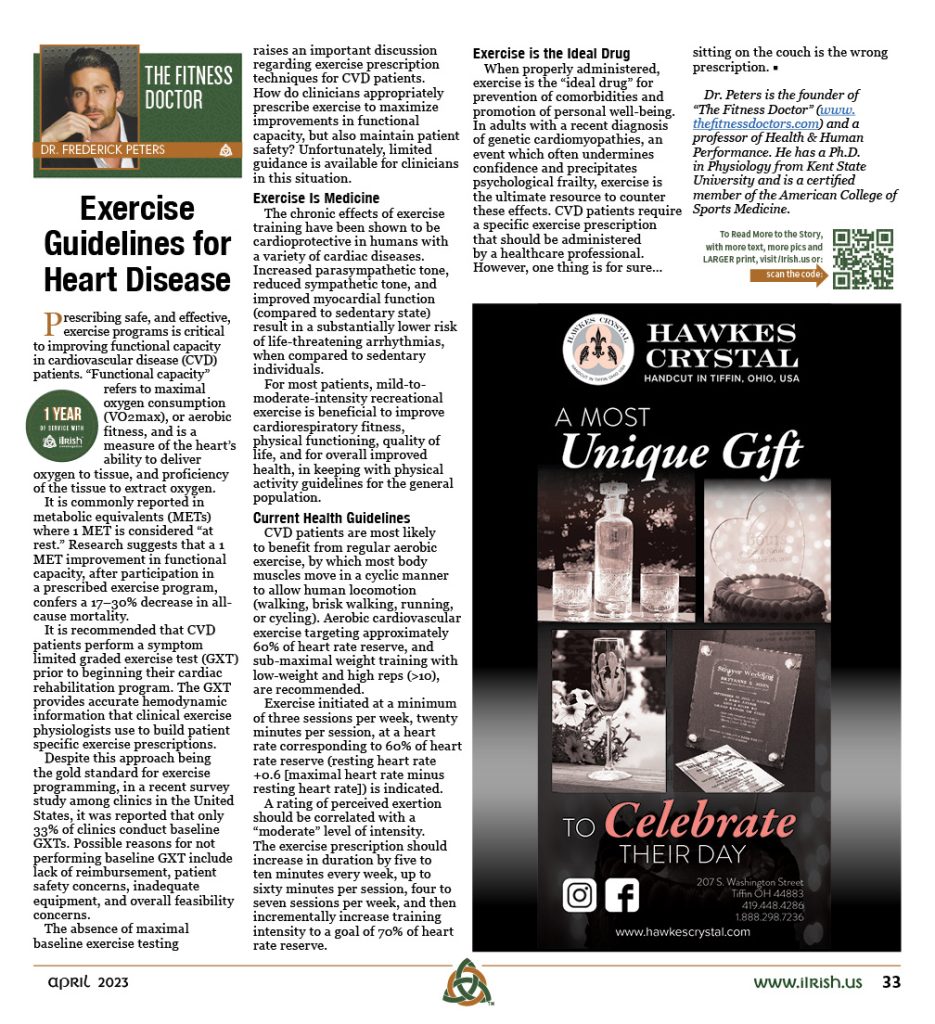

Fitness Dr.: Exercise Guidelines for Heart Disease
Dr. Fredrick Peters
Prescribing safe, and effective, exercise programs is critical to improving functional capacity in cardiovascular disease (CVD) patients. “Functional capacity” refers to maximal oxygen consumption (VO2max), or aerobic fitness, and is a measure of the heart’s ability to deliver oxygen to tissue, and proficiency of the tissue to extract oxygen.
It is commonly reported in metabolic equivalents (METs) where 1 MET is considered “at rest.” Research suggests that a 1 MET improvement in functional capacity, after participation in a prescribed exercise program, confers a 17–30% decrease in all-cause mortality.
It is recommended that CVD patients perform a symptom limited graded exercise test (GXT) prior to beginning their cardiac rehabilitation program. The GXT provides accurate hemodynamic information that clinical exercise physiologists use to build patient specific exercise prescriptions.
Despite this approach being the gold standard for exercise programming, in a recent survey study among clinics in the United States, it was reported that only 33% of clinics conduct baseline GXTs. Possible reasons for not performing baseline GXT include lack of reimbursement, patient safety concerns, inadequate equipment, and overall feasibility concerns.
The absence of maximal baseline exercise testing raises an important discussion regarding exercise prescription techniques for CVD patients. How do clinicians appropriately prescribe exercise to maximize improvements in functional capacity, but also maintain patient safety? Unfortunately, limited guidance is available for clinicians in this situation.
Exercise Is Medicine
The chronic effects of exercise training have been shown to be cardioprotective in humans with a variety of cardiac diseases. Increased parasympathetic tone, reduced sympathetic tone, and improved myocardial function (compared to sedentary state) result in a substantially lower risk of life-threatening arrhythmias, when compared to sedentary individuals.
For most patients, mild-to-moderate-intensity recreational exercise is beneficial to improve cardiorespiratory fitness, physical functioning, quality of life, and for overall improved health, in keeping with physical activity guidelines for the general population.
Current Health Guidelines
CVD patients are most likely to benefit from regular aerobic exercise, by which most body muscles move in a cyclic manner to allow human locomotion (walking, brisk walking, running, or cycling). Aerobic cardiovascular exercise targeting approximately 60% of heart rate reserve, and sub-maximal weight training with low-weight and high reps (>10), are recommended.
Exercise initiated at a minimum of three sessions per week, twenty minutes per session, at a heart rate corresponding to 60% of heart rate reserve (resting heart rate +0.6 [maximal heart rate minus resting heart rate]) is indicated. A rating of perceived exertion should be correlated with a “moderate” level of intensity.
The exercise prescription should increase in duration by five to ten minutes every week, up to sixty minutes per session, four to seven sessions per week, and then incrementally increase training intensity to a goal of 70% of heart rate reserve.
Exercise is the Ideal Drug
When properly administered, exercise is the “ideal drug” for prevention of comorbidities and promotion of personal well-being. In adults with a recent diagnosis of genetic cardiomyopathies, an event which often undermines confidence and precipitates psychological frailty, exercise is the ultimate resource to counter these effects. CVD patients require a specific exercise prescription that should be administered by a healthcare professional. However, one thing is for sure… sitting on the couch is the wrong prescription.
*Dr. Peters is the founder of “The Fitness Doctor” (www.thefitnessdoctors.com) and a professor of Health & Human Performance. He has a Ph.D. in Physiology from Kent State University and is a certified member of the American College of Sports Medicine. Dr. Peters is also a graduate of St. Ignatius High School and John Carroll University. If you found this article interesting, read more on his website. He can be reached at [email protected].


Monthly newsmagazine serving people of Irish descent from Cleveland to Clearwater. We cover the movers, shakers & music makers each and every month.
Since our 2006 inception, iIrish has donated more than $376,000 to local and national charities.
GET UPDATES ON THE SERIOUS & THE SHENANIGANS!